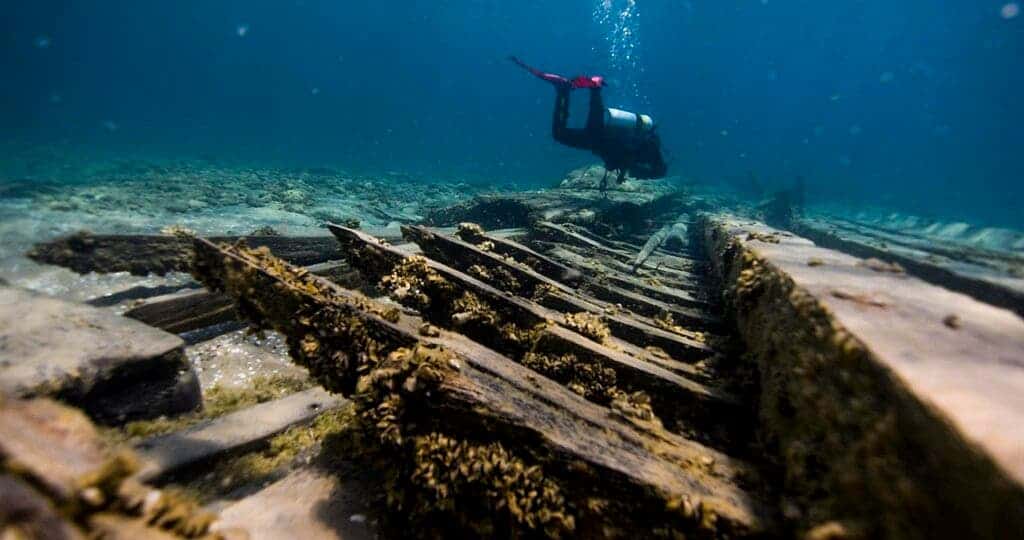Shipwrecks do more than cut lucrative deals short — they also alter seafloor microbial communities, at least in the case of wooden ships.

A new study led by researchers at the University of Southern Mississippi reports that historic, wooden shipwrecks have produced local changes in the microbial communities at the bottom of the sea where they lay. The millions of such shipwrecks strewn throughout the world’s oceans each create a potentially-unique habitat and micro-ecosystem for different strains to inhabit.
These findings, the team explains, are the first evidence of how human structures are impacting the distribution of microbes on the deep-sea floor.
Shipwrecked communities
“Microbial communities are important to be aware of and understand because they provide early and clear evidence of how human activities change life in the ocean,” said corresponding author Dr. Leila Hamdan of the University of Southern Mississippi. “Ocean scientists have known that natural hard habitats, some of which have been present for hundreds to thousands of years shape the biodiversity of life on the seafloor.”
“This work is the first to show that built habitats (places or things made or modified by humans) impact the films of microbes (biofilms) coating these surfaces as well. These biofilms are ultimately what enable hard habitats to transform into islands of biodiversity.”
Just like naturally-occurring geological features on the seafloor, wooden shipwrecks create habitats that deep-sea microbes can inhabit. While we did know that wooden shipwrecks can harbor impressive communities of macroscopic life inside the hulls of the former ships, we had very little data about the microbes that also inhabit these structures.
Since microbes are the foundation of ocean food chains, understanding how man-made structures (including shipwrecks) can impact their diversity can teach us a lot about how to better protect the oceans. According to UNESCO estimates, there are as many as three million shipwrecks all around the world, most of which are made of wood.
In order to better understand the local effect of shipwrecks, the team worked with two sites, the wrecks of wooden sailing ships that both sank in the Gulf of Mexico in the late 19th century.
UNESCO estimates that there are as many as three million shipwrecks around the world, most of which are made of wood. As an initial study of the microbial life around such sites, Hamdan and her collaborators chose two wooden sailing ships that sank in the Gulf of Mexico in the late 19th century. Samples were collected from these sites by placing pieces of pine and oak wood at various distances (0-200 meters) from the shipwrecks and leaving them there for four months. After recovery, these pieces of wood were analyzed for their contents of bacteria, archaea, and fungi using gene sequencing.
The type of wood used had the greatest impact on the diversity of bacteria seen in the samples of microbes — oak was more to the taste of these diminutive critters than pine — although it had a much lower influence on archaea and fungi diversity.
Meanwhile, the single greatest influence on the overall diversity of species identified in the samples was proximity to the site. Surprisingly, however, it wasn’t the ones closest to the shipwrecks that showed the greatest variety, but those that were about 125 meters away from the downed ships.
Overall, the team explains that the presence of shipwrecks does have a meaningful impact on the microbial richness of their surrounding area, with important changes to biofilm composition and dispersal. Environmental factors such as depth and local availability of nutrients also influenced the behavior of biofilms at the site of a shipwreck, the team adds.
Although the current paper focuses on wooden shipwrecks, the authors note that many of today’s man-made undersea structures are made of metal — oil and gas platforms or pipelines, for example, are strewn throughout the world. Further research will be needed to understand the impact of such a structure as well.
While we are aware human impacts on the seabed are increasing through the multiple economic uses, scientific discovery is not keeping pace with how this shapes the biology and chemistry of natural under sea landscapes,” said Hamdan. “We hope this work will begin a dialogue that leads to research on how built habitats are already changing the deep sea.”
The paper “Historic Wooden Shipwrecks Influence Dispersal of Deep-Sea Biofilms” has been published Frontiers in Marine Science.


